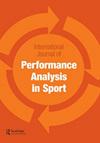羽毛球精英选手单打扣球和扣球-箭步序列的意义
IF 1.6
4区 教育学
Q1 Health Professions
International Journal of Performance Analysis in Sport
Pub Date : 2022-05-02
DOI:10.1080/24748668.2022.2069936
引用次数: 0
摘要
摘要:本研究考察了精英男子单打比赛中扣球的数量和扣球-箭步组合。分析了2016年奥运会、大奖赛和世界超级系列赛的半决赛和决赛视频。在一场比赛和整场比赛中,对胜者和败者通过扣球和扣球-弓步序列获得的分数进行比较,并分析扣球-弓步序列获得的分数是立即获得的,还是在三回合或更长时间内获得的。在一场比赛中,胜者在扣球(4.8±1.9比3.5±1.3分)和扣球-弓步组合(4.0±2.8比1.7±1.6分)上的得分高于败者(p < 0.05)。在扣球(11.0±2.6)和扣球-弓步组合(7.4±4.8)中,比赛胜利者比比赛失败者(分别为8.2±3.0和5.5±3.7)获得更多积分(p < 0.05)。比赛中,胜者比败者多获得5-10%的扣分(p < 0.05),且60%的分数都是直接从扣分中获得的。在羽毛球运动中,扣球-箭步的顺序很重要。胜者比败者更能有效地从这个顺序中得分,特别是在紧接扣球-弓步的顺序中得分,而不是在接下来的回合中得分。因此,改进冲腿-弓步动作的技术是必要的。本文章由计算机程序翻译,如有差异,请以英文原文为准。
Significance of smash and smash-lunge sequence in singles badminton matches in elite players
ABSTRACT This study examined the number of smashes and smash-lunge sequences in elite men’s singles matches. Semi-final and final match videos of the Olympic Games, Grand-Prix, and World-SuperSeries in 2016 were analysed. Points won from smashes and smash-lunge sequence in a game and an entire match were compared between the winners and losers, and whether points won from the smash-lunge sequence occurred immediately, within three rallies or more were analysed. The game winners scored more (p < 0.05) points than the losers in a game from smashes (4.8 ± 1.9 vs 3.5 ± 1.3 points) and from smash-lunge sequences (4.0 ± 2.8 vs 1.7 ± 1.6 points). Match winners won more (p < 0.05) points from smashes (11.0 ± 2.6) and smash-lunge sequences (7.4 ± 4.8) than match losers (8.2 ± 3.0 and 5.5 ± 3.7, respectively). The match winners won 5–10% more points from the smash-lunge sequence than losers (p < 0.05), and 60% of the points were won immediately from the smash-lunge sequence for both the winners and losers. The smash-lunge sequence is important in badminton. Winners were more effective than the losers at scoring points from this sequence, and in particular, at winning points immediately off the smash-lunge sequence, rather than in the following rallies. Thus, improving the techniques of the smash-lunge sequence is necessary.
求助全文
通过发布文献求助,成功后即可免费获取论文全文。
去求助
来源期刊

International Journal of Performance Analysis in Sport
SPORT SCIENCES-
CiteScore
4.70
自引率
4.80%
发文量
38
审稿时长
>12 weeks
期刊介绍:
The International Journal of Performance Analysis in Sport aims to present current original research into sports performance. In so doing, the journal contributes to our general knowledge of sports performance making findings available to a wide audience of academics and practitioners.
 求助内容:
求助内容: 应助结果提醒方式:
应助结果提醒方式:


